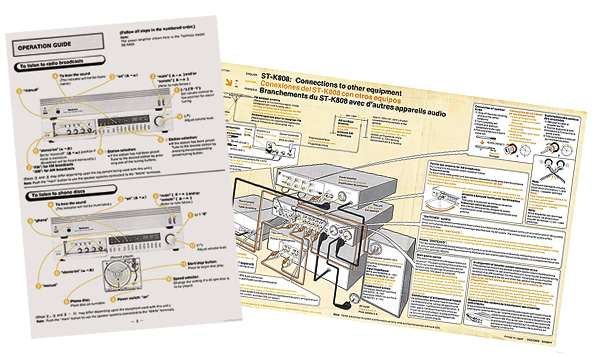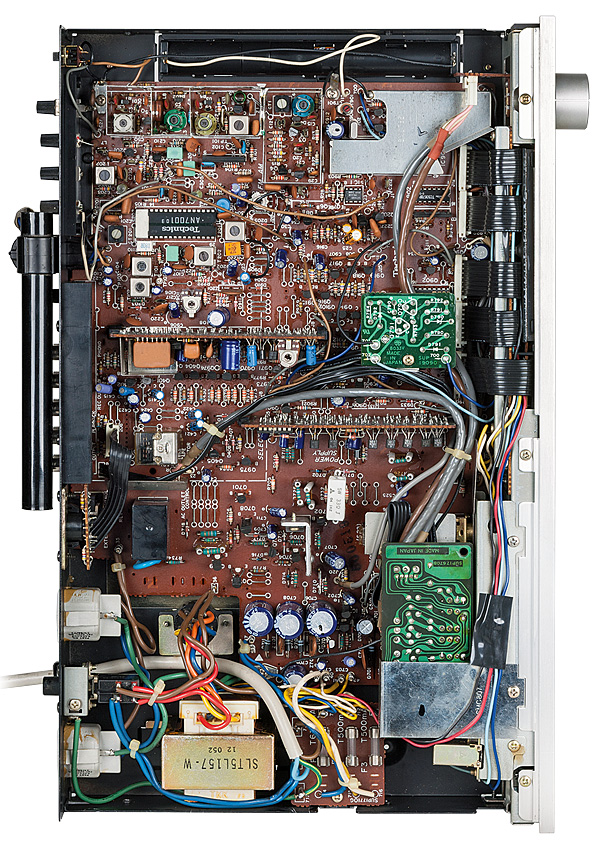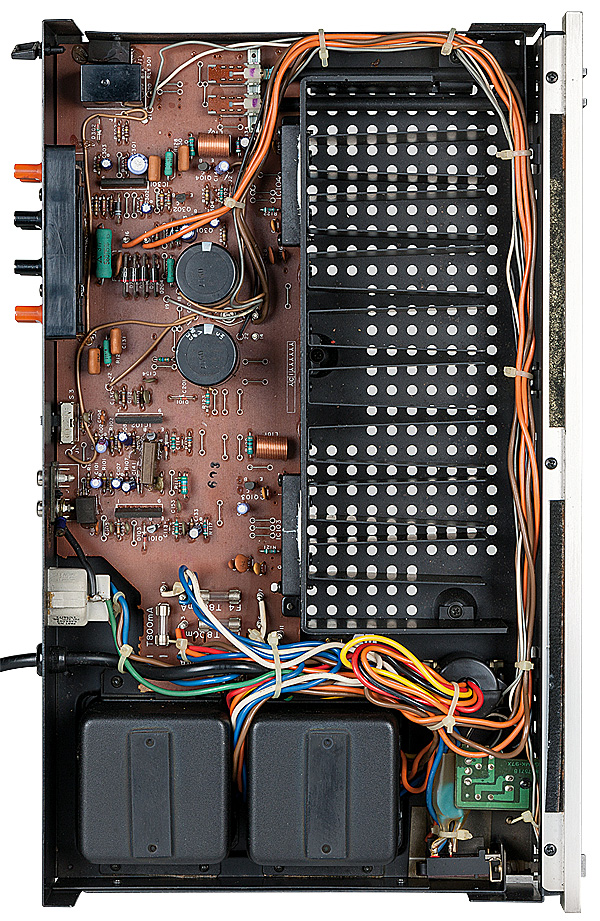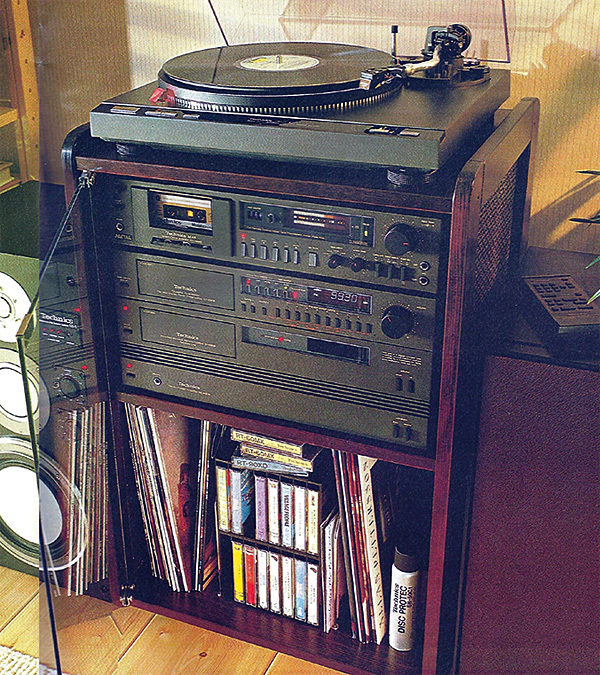Technics ST-K808/SE-A808 'preceiver'/power amplifier Page 2
![]() Tim Listens
Tim Listens
To begin with, the inclusion of the timer makes the ST-K808 a fiddly unit to use at first. The main power switch is on the rear while the little button on the front, which one would expect to press to switch the unit on, actually puts the ST-K808 into standby. To switch it on, one must select one of the sources, then it all comes to life.

There are inputs for a turntable (MM) and an auxiliary line-level source, along with a tape loop that includes monitoring facilities. For this UK market model the RCA tape connections are duplicated in a DIN socket, the other DIN socket being a proprietary data input from the remote control receiver.
The aerial connections are nicely designed and include a clamp which fits directly over a standard 75ohm coax cable. Setting up the preset stations is relatively straightforward and can be accomplished quickly. A small indicator labelled 'Quartz Lock' shows when the correct point of tune has been found. The connections between the pre and power amplifiers use standard RCA cables and are at standard impedances and levels, meaning that both of the units can be used with other equipment. The SE-A808 has the standard Technics twist-to-lock loudspeaker connectors for bare ended cables and couldn't be simpler to set up and use.
At normal listening levels this classic Technics pairing serves up no nasty surprises. With the tone controls at their mechanical midpoint the sound was a little dull, but advancing the treble control to the one o'clock position countered this and balanced things up nicely.
Musically everything was tidy and well ordered, with a good sense of insight and a wide, deep soundstage. Dynamically the duo was perhaps a bit restricted, with a distinct lack of the bite and sparkle that made the JVC A-X4 [HFN Oct '17] such a compelling listen. By direct comparison the Technics is perhaps a little bland, when playing quietly at least.

Having almost identical power ratings to the Aurex Micro System 15 [HFN Apr '16], it came as no surprise that the ST-K808 and SE-A808 could play at high levels easily. Pushing up the volume revealed the power amplifier's greatest strength: its ability to preserve bass detail and integrity even when operating at near full output. One had to get almost into audible clipping before the sound's structure began to fall apart. In this respect the combination was quite remarkable. Used with the wick cranked up, the pair delivered a presentation that really engaged.
Forensic Tool
Sade's 'Cherry Pie' from Diamond Life [Epic CDEPC 26044] revealed the ST-K808 and SE-A808 to have a slightly forward upper midrange – a common Japanese trait of this era – along with marginally curtailed bass. It was in the presentation of the texture of each sound that it really excelled, especially at the bottom end. What I was expecting to be a warm and fuzzy-sounding source on which to play background music during dinner parties turned out to be a focused tool for forensic musical research. Who'd have guessed?
Faster-paced material, such as that found on New Order's 1989 album Technique [Factory FACD 275.2] was also laid bare, with dead-on-time rhythms and gloriously gritty synths. An amplifier out of its depth would smear all this into an incoherent tangle of noise.
The FM section of the ST-K808 also proved its worth. Some background digital 'hash' was faintly audible when receiving distant stations well beyond their intended service area but there were no such problems with those more reasonably 'in range'.

Sensitivity appeared good, with rapid AFC and stereo decoder locking when paging through the pre-set programmes. BBC Radio 4 (92.5MHz) benefited from the ST-K808's ability to capture and portray studio ambience, giving the early evening PM news programme a level of realism easily lost by poor tuners and inferior mediums.
Meanwhile, live concert material on BBC Radio 3 (90.3MHz) also enjoyed a pleasing sense of space around it, with fine stereo placement and near silent interludes to complete my enjoyment.
Buying Secondhand
Of the two components the ST-K808 is the bigger source of problems. Because of the hidden power switch and clock function, it was usual to leave this unit powered all the time and the long-term exposure to heat can take its toll on the power supply components, usually the regulator transistors and the various reservoir capacitors associated with them.

Repairs would be straightforward except for the fact that the chassis is constructed in such a way that access to the underside of the PCB is extremely difficult. This same issue also makes the relay that controls the tape loop (the most common cause of poor channel balance or complete absence) difficult to remove and clean.
If the tuning display shows only an 'E' when the set is first switched on the cause is normally exhausted batteries underneath. Use only leak-proof alkaline types to avoid corrosion problems.
The SE-A808 has proved itself to be largely trouble free. If there is no output and the muting relay fails to 'click' audibly a second or so after switching on then the unit is probably in 'protection mode' as the result of a damaged hybrid chip. Availability is sporadic and they can be expensive, so ensure that all the speaker connections are sound and that there is no possibility of short-circuits before applying the power.
Hi-Fi News Verdict
While perhaps not an obvious choice for someone looking for a classic Japanese pre/power combo, the Technics ST-K808 and SE-A808 duo has nevertheless shown itself to be something of a forgotten gem. Some may find its sound a bit conservative, but with the right partnering equipment these units can really shine. The matching RS-M45 direct-drive cassette deck is an outstanding performer too.


























































